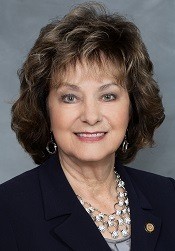
Joyce Krawiec serves in the North Carolina Senate. She represents Davie County and Forsyth County, NC. Christian, wife, mother, small business owner, and conservative.
How often have we heard the phrase, ‘follow the science’ since the beginning of the pandemic? Many of those who have been yelling from the rooftops to follow the science are now saying, “not so fast, that’s not enough science to follow.”
This past week was very busy in Raleigh. We had two important bills that were passed. The first was a Covid Relief Modifications Bill. Not much controversy there. It was a bill to make modifications to the Covid Relief bill that was passed earlier. Some deadlines needed to be extended and some funds that were unspent needed to be rerouted so they wouldn’t be required to be returned to the federal government. This bill passed unanimously.
The second bill should not have been controversial but it turned out to be very much so. It was Senate Bill 37 which required schools to offer in person learning, if parents choose that option for their children. You would think we were taking away the first born from the reaction of some of my colleagues.
This bill simply puts the decision back where it belongs, with parents. Parents know what is best for their children. It will be up to them whether or not to permit their child to return to in person learning.
First, let’s look at the science. There is a mountain of scientific research and data that points to schools being able to safely reopen.
One specific study here in North Carolina was done by researchers at Duke and UNC through the ABC Collaborative. This was an extensive study that followed 93,000 students who have remained in the classroom during the pandemic. There is not one case of transmission from student to student or student to teacher. The only reported cases transferred were from staff. It was also noted that all of the schools followed the safety guidelines as recommended in the NC Healthy Toolkit.
Researchers also found that even in communities with widespread transmission, schools were safer than the community. “During the study timeframe, we saw significant community spread of COVID-19,” said DCRI pediatrician Danny Benjamin, MD, PhD, MPH, co-chair of the ABC Science Collaborative. “If we’d seen the same rates of secondary transmission in the schools as we were seeing in the community, we would have expected between 800 and 900 secondary infections. However, we saw only 32. This indicates that it is possible for schools to safely remain open in communities with widespread community transmission.”
Many other studies have the same finding. There are national studies as well as global studies that recommend students return to the classroom. Remember, many schools never closed in other states and other countries, so there is plenty of evidence… Um, ‘scuse me, ‘Science.’
There is also a mountain of evidence showing the harm being done to children by not being allowed in the classroom. Harvard public health experts say, “children are severely harmed by continued school closings. Some children may never recover.”
At a recent oversight committee in Raleigh, education experts gave some startling statistics. The retention rates (holding children back at current grade level) may be the highest we have seen in 100 years. They also found it is likely to be several years, if ever, before all students will catch up. Most frightening of all is the fact that more than 30,000 students are unaccounted for in our NC school system.
Other findings are that students who do not attend in person learning face greater health risks. These include difficulty accessing health care services typically provided through school, social isolation and limited physical activities. Children are at higher risk of abuse since school officials are common reporters of suspected abuse. Students not attending in person school face more emotional or behavioral challenges due to disruptions to routines. There is also added stress due to family hardships and economic fallout. Many low income children are also suffering from nutritional needs without access to food through school meal programs.
Depression and suicide rates are staggering since the pandemic. The emotional toll on our children is a far greater danger than any threat from a spread of Covid in the classroom.
The Governor received word of our upcoming bill to return students to the classroom. He preempted the vote with a press conference “urging local school districts to return to in person learning.” Urging is not enough, Governor. Show some leadership.
Even with all of this data, it is still not enough. Only two Democrats crossed the aisle and voted with the majority to reopen schools. Parents and children overwhelmingly want to return to the classroom. Many teachers also want to get back in the classroom. There are however some teachers and all teachers unions that simply don’t want to consider it.
CLICK HERE TO SEE THE VOTES ON THIS BILL
Some reasons given are that schools shouldn’t be reopened until all teachers have received vaccines. CDC Guidelines disagree, “There is increasing data to suggest that schools can safely reopen and that safe reopening does not suggest that teachers need to be vaccinated in order to reopen safely,” CDC Director Rochelle Walensky told reporters at a briefing. “Vaccination of teachers is not a prerequisite for the safe reopening of schools.”
Governor Cooper has determined the guidelines for vaccine distribution. Teachers are considered essential workers and are scheduled for the next round of vaccines. However, the Governor could have moved them up at any time, if that were really a reason for delaying reopening of schools.
As usual, our children have become political pawns in an issue that shouldn’t be political at all.
Let’s follow the science and let parents decide if their children should be in school.
Recent Posts

Joyce Krawiec serves in the North Carolina Senate. She represents Davie County and Forsyth County, NC. Christian, wife, mother, small business owner, and conservative.
